StemUp: OCR A A level Physics 6.3: Electromagnetism
1/60
There's no tags or description
Looks like no tags are added yet.
Name | Mastery | Learn | Test | Matching | Spaced |
|---|
No study sessions yet.
61 Terms
What is a magnetic field? (1)
A magnetic field is a region of space in which moving charged particles are subject to a magnetic force.
What causes a magnetic field? (1)
A magnetic field is caused by moving charges or permanent magnets.
What is meant by a permanent magnet? (1)
This is an object made from a magnetised material which creates its own permanent magnetic field.
What causes a magnetic force? (1)
The interaction between two magnetic fields results in a magnetic force.
Where do magnetic field lines point? (1)
These point from the north pole to the south pole and show the direction of the magnetic force on a moving charge.
What is the magnetic field pattern for a long, straight current-carrying conductor? (1)
This looks like:
The direction of the magnetic field depends on which direction the current is flowing in.
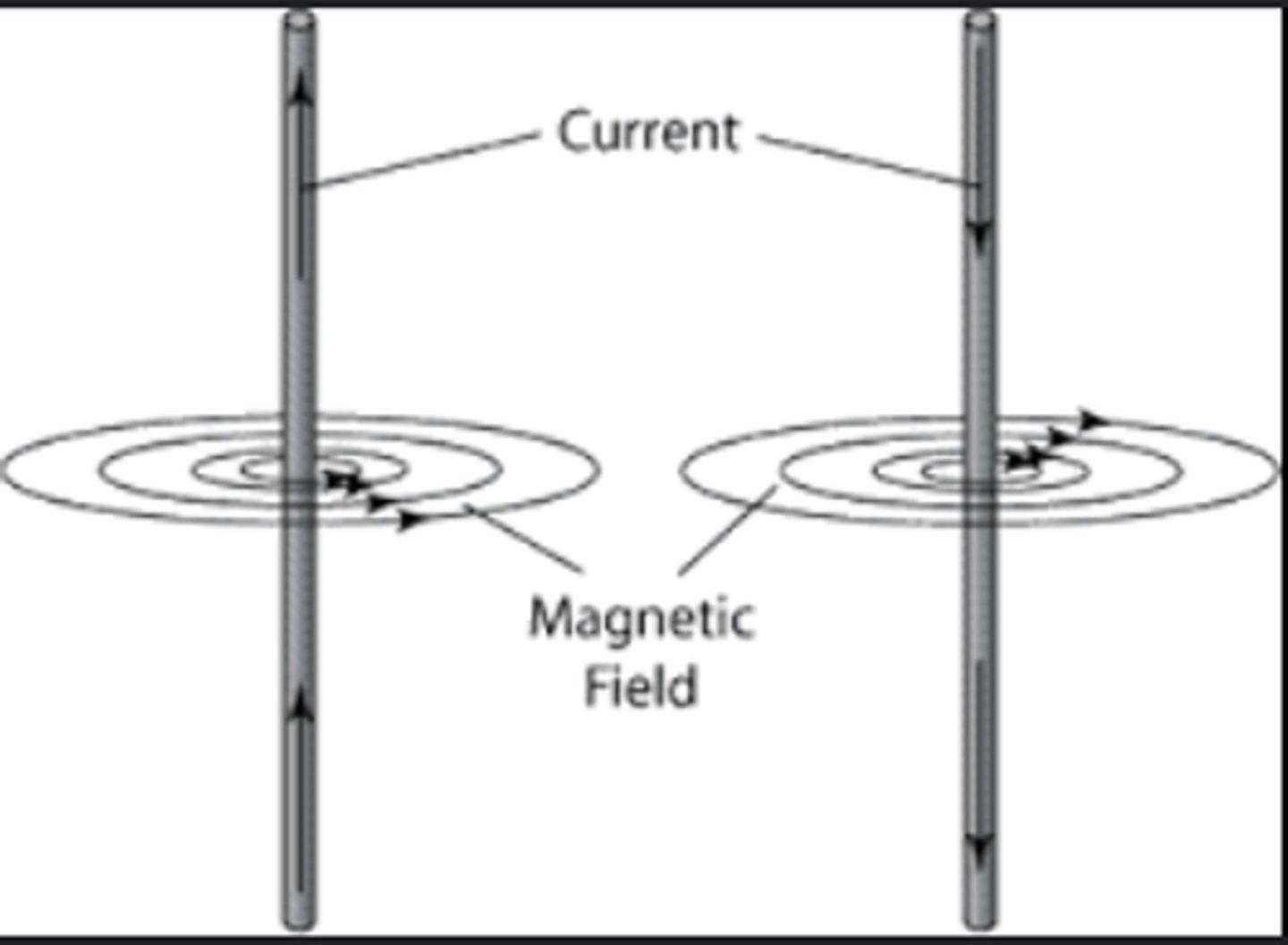
What is the magnetic field pattern for a flat coil? (1)
This looks like:
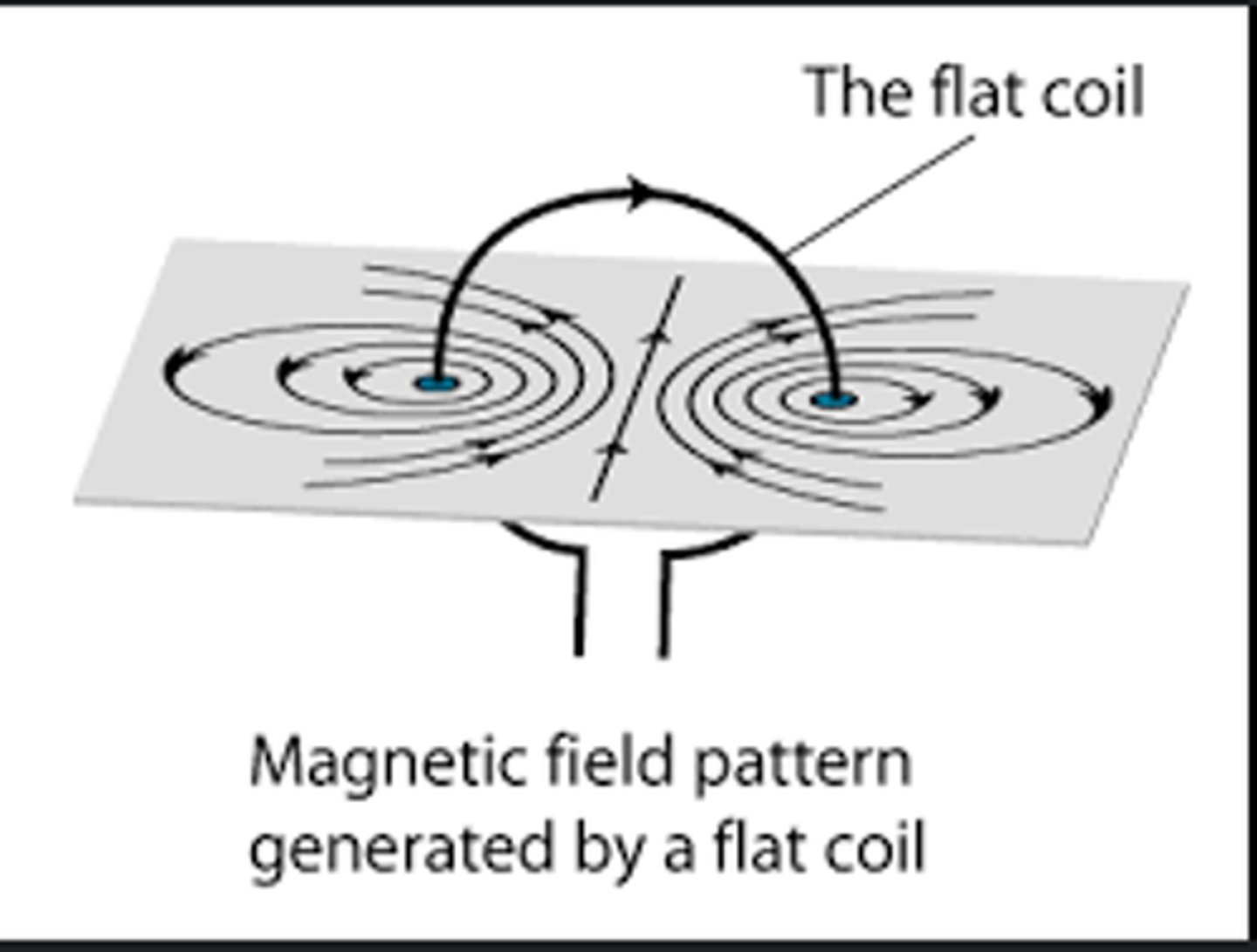
What is the magnetic field pattern for a long solenoid? (1)
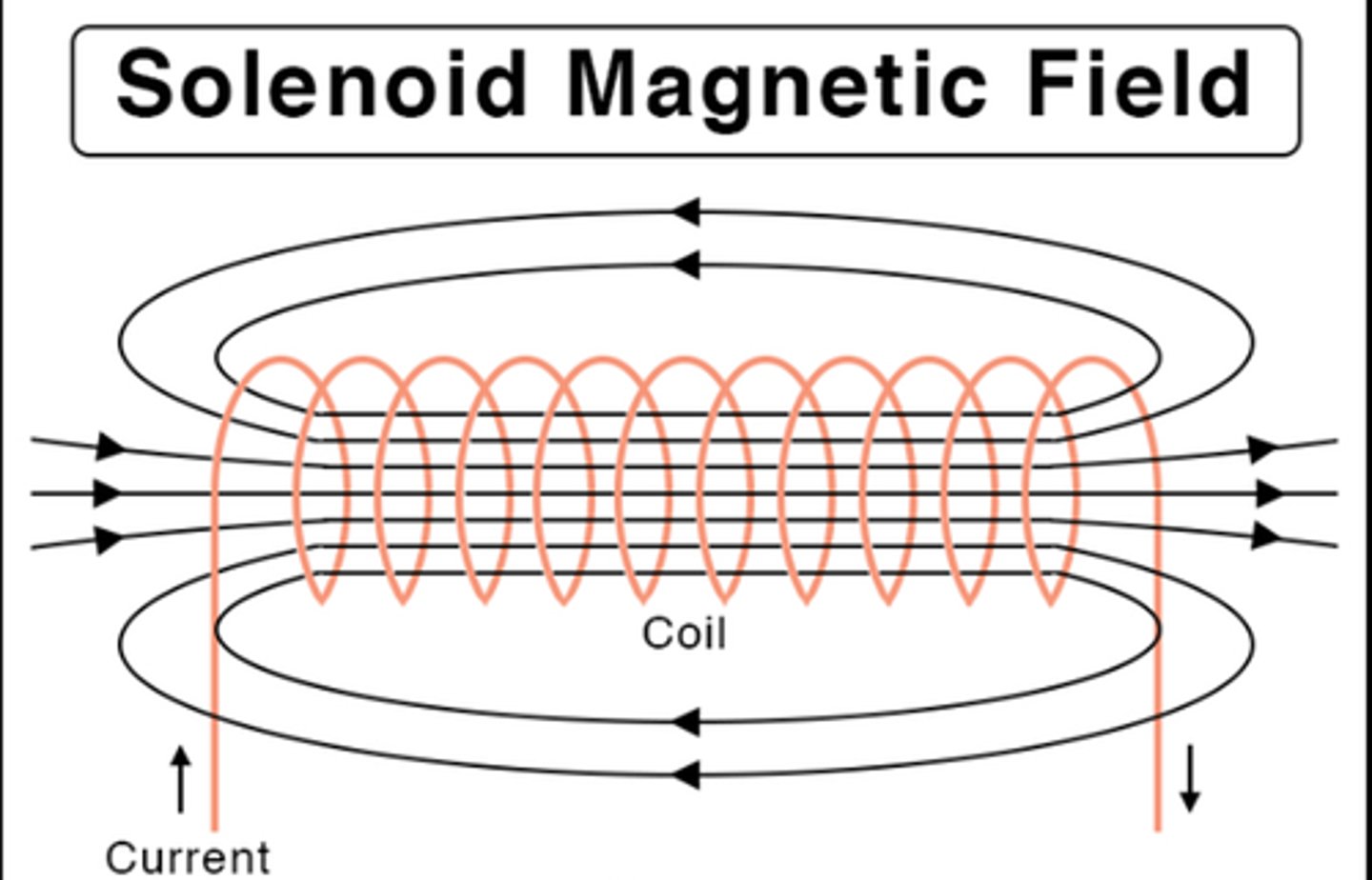
How can an inwards or outwards current or field line be represented in a 2D magnetism diagram? (2)
- A dot inside a circle represents a current or field line coming out of the plane of the page (towards you).
- A cross represents a current or field line pointing into the plane of the page (away from you).
What is Fleming's left hand rule used for? (1)
This is used when finding the direction of a force in a magnetic field.
How is Fleming's left hand rule carried out? (4)
- The thumb, index finger and middle finger all are held at right angles to each other.
- The index finger points in the direction of the magnetic field.
- The middle finger points in the direction of the current.
- The thumb points in the direction of the force.
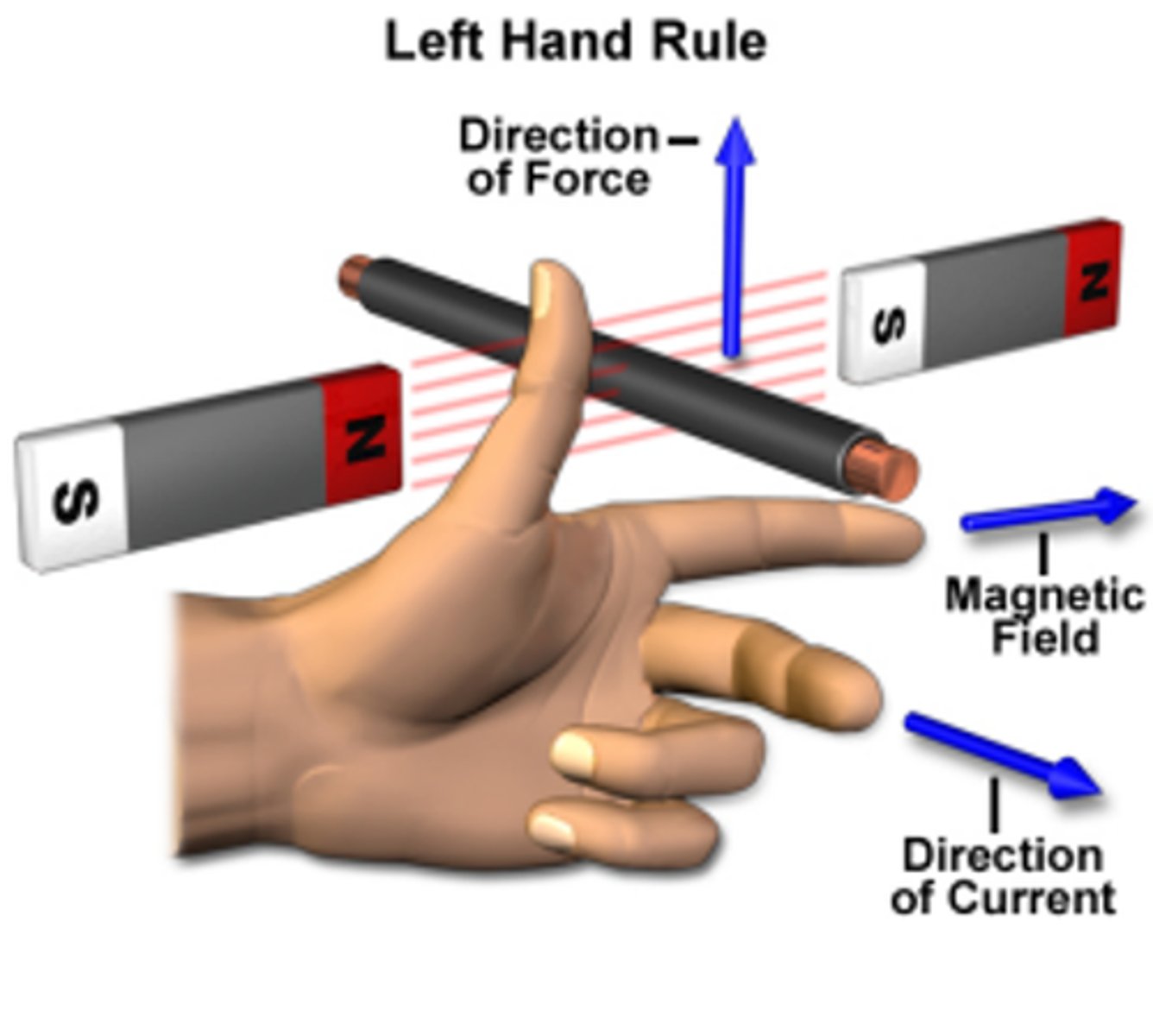
What is meant by magnetic flux? (1)
This is defined as the product of the magnetic flux density and the area perpendicular to the lines of flux.
What is the unit for magnetic flux? (1)
This is measured in the unit Weber (Wb)
What is meant by magnetic flux density? (1)
This is defined as the magnetic flux per unit area.
What is the unit for magnetic flux density? (1)
This is measured in Weber per meter squared (Wbm^-2) or the unit Tesla (T).
What is the equation for the magnetic force on a current-carrying conductor? (1)
- This is given by F = BILsinθ
- Where F is the magnetic force (N), B is the magnetic flux density (T), I is the current in the conductor (A), L is the length of the conductor (m) and θ is the angle between the current and the magnetic field.
When is the magnetic force on a current-carrying conductor at its greatest value? (1)
When the current and magnetic field are perpendicular to each other. As sin θ = 1 when θ = 90 degrees so F =BILsinθ will be at its maximum.
How can the uniform magnetic flux density be found between the poles of a magnet? (5)
- Place a horseshoe magnet on a set of scales which have been calibrated correctly.
- Connect a wire in series with a DC power supply, variable resistor and an ammeter. Also measure the length of the wire.
- Align the wire so the magnetic force acting on it is upwards (from Fleming's left hand rule) so the force on the magnet is downwards (due to Newton's third law).
- The scale will record the magnetic force as weight, vary the current using the variable resistor and record a table of current and mass for different values of current.
- Plot a graph of mass against current in the wire. By equating the forces mg = BIL and the gradient (m/I) will equal BL/g so the magnetic flux density (B) can be found as we know the length (L) and the value of g.
What is the equation for the force on a moving charged particle at right angles to a magnetic field? (2)
- This is given by F = BQv
- Where F is the magnetic force applied on the particle (N), B is the magnetic flux density (T), Q is the charge on the moving particle (C) and v is the velocity of the particle (ms^-1)
How is the equation for the force on a moving charged particle at right angles to a magnetic field derived? (3)
- As the particle is at a right angle the force is given by F = BIL
- But current is given by Q/t and L is given by vt due to speed = distance/time
So the force is written as F = BQv as t cancels out.
How does a charged particle move in a uniform magnetic field? (1)
The movement of the particle produces a force perpendicular to its velocity so the particle follows a curved trajectory that transcribes a circle.
What provides the centripetal force for charged particles in a uniform magnetic field? (1)
The magnetic force on the particle produces the centripetal force for it to move in a circle, so: mv^2/r = BQv
What is the equation of the radius of a circle that a charged particle is moving in? (2)
- This is given by: r = mv/BQ = P/BQ
- Where r is the radius of the circle (m), v is the velocity of the particle (ms^-1), B is the magnetic flux density (T) and Q is the charge of the particle (C).
How can a charged particle moving in a uniform magnetic field be identified? (1)
Using the equation r = mv/BQ = P/BQ some particles have a specific momentum-charge ratio so they can be identified.
What is a velocity selector? (1)
These use a combination of electric and magnetic fields to isolate particles which have a specific velocity.
How does a velocity selector work? (3)
- A uniform electric field must act in the opposite direction to a magnetic field.
- Two parallel plates with a voltage across them are placed at right angles to a uniform magnetic field produced from a horseshoe magnet.
- Particles at a specific velocity given by v = E/B where E is the electric field strength and B is the magnetic flux density will travel in a straight line which separates particles.
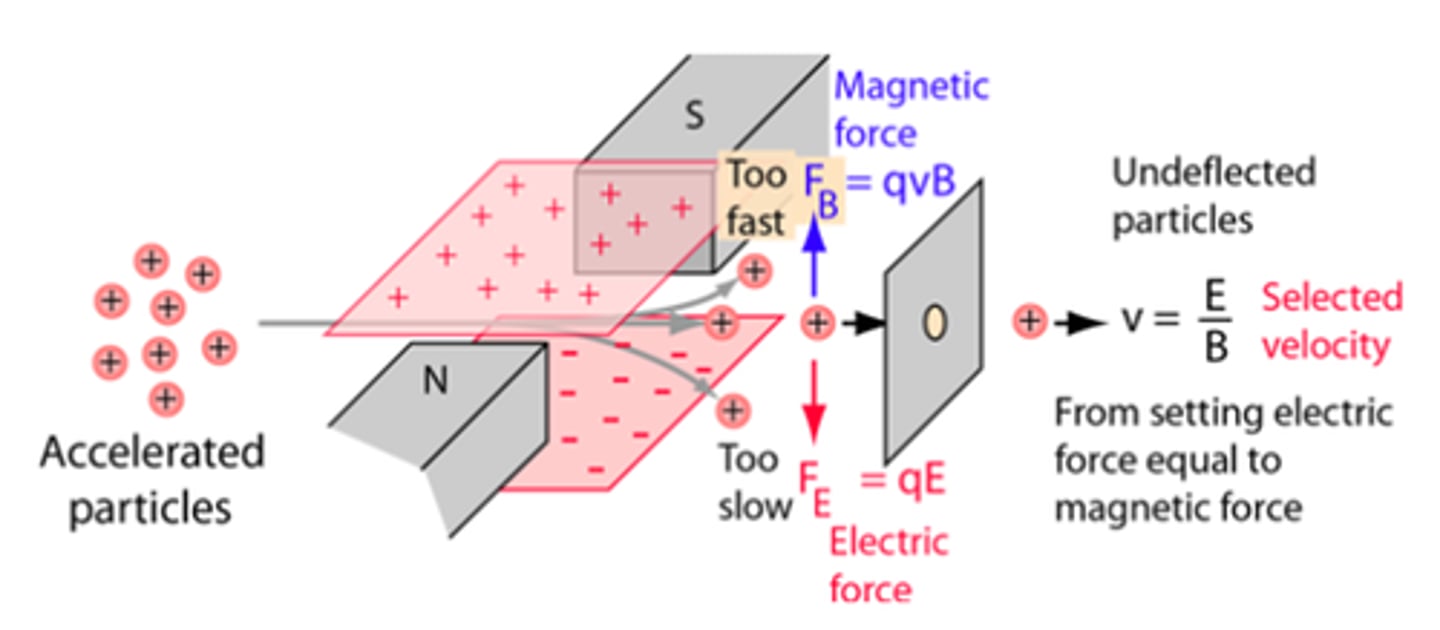
What is the velocity selector equation? (3)
- This is given by v =E/B
- Where v is the velocity of the particle (ms^-1), E is the electric field strength (NC^-1) and B is the magnetic flux density (T).
- Particles travelling at this velocity will travel in a straight line and will not collide with plates.
What are velocity selectors used in? (1)
They are used in mass spectroscopy which is a method of determining the molecular formula of an unknown substance.
What is the equation for magnetic flux? (2)
- This is given by: Φ = BAcosθ
- Where Φ is the magnetic flux (Wb), B is the magnetic flux density (T), A is the area perpendicular to the lines of flux (m^2) and θ is the angle between the area and the magnetic flux lines.
What is meant by the magnetic flux linkage in a coil? (1)
This is defined as the sum of the magnetic flux in each turn of the coil and can also be defined as the product of the magnetic flux and the turns in the coil.
What is the equation for the magnetic flux linkage? (2)
- This is given by: NΦ = BAcosθ
- Where N is the number of turns in the coil, Φ is the magnetic flux (Wb), B is the magnetic flux density (T), A is the area perpendicular to the lines of flux (m^2) and Φ is the angle between the area and the magnetic flux lines.
What is meant by electromagnetic induction? (1)
This is when a current is induced due to a change in the magnetic flux linkage.
What does Faraday's law of electromagnetic induction state? (1)
This states that the induced e.m.f is proportional to the rate of change of magnetic flux linkage.
What does Lenz's law state? (1)
This states that the induced emf produced from Faraday's law is generated in a direction that opposes the change that produced it.
What is Lenz's law a consequence of? (2)
- It is a consequence of the conservation of energy.
- If a wire is pushed into a magnetic field it will produce electrical energy which results from work done on the wire so energy is conserved.
How can Faraday's law and Lenz's law apply to a wire and a magnetic field? (2)
- If a wire in pushed in a magnetic field there will be a change in the magnetic flux linkage and an emf will be produced.
- The current in a wire will be in a direction that produces a force to oppose its motion in the magnetic field.
What is the equation combining Faraday's law and Lenz's law? (2)
- This is given by: ε = -∆(NΦ)/ ∆t
- Where ε is the induced emf (V), ∆N\Φ is the change in magnetic flux linkage and ∆t is the change in time that this occurs over.
What is a search coil? (1)
This a flat coil of insulated wire connected to a galvanometer (a sensitive ammeter).
How can the magnetic flux be investigated using search coils? (3)
- A search coil is placed into a known magnetic field and then removed rapidly.
- The current measured by the galvanometer is proportional to the magnetic field strength.
- The magnetic flux density can then be calculated from this along with the magnetic flux if the area and number of turns on the coil are known.
What is meant by a generator? (1)
This converts kinetic energy into electrical energy which can then be used to power electrical appliances.
What is meant by a A.C generator? (1)
This is a generator which has an alternating current due to a changing magnetic flux linkage.
What is a simple example of an A.C generator? (2)
- A coil of wire can be placed in a constant uniform magnetic field.
- The coil is rotated so the area perpendicular to the magnetic field constantly changes which changes the magnetic flux linkage and induced an alternating current in the wire.
How does the induced emf and flux linkage change over time in an A.C generator? (2)
- At maximum flux linkage, the rate of change of flux linkage is zero so the induced emf is also zero.
- At zero flux linkage, the induced emf is at a maximum.
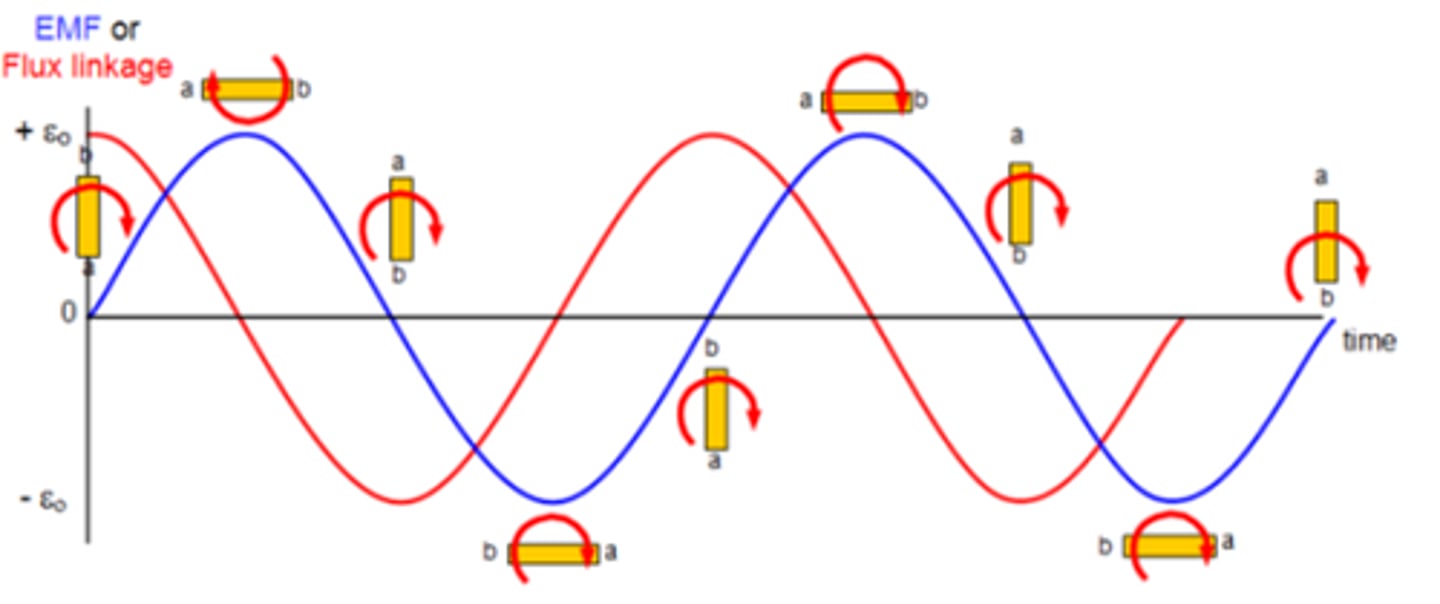
What does a transformer look like? (1)
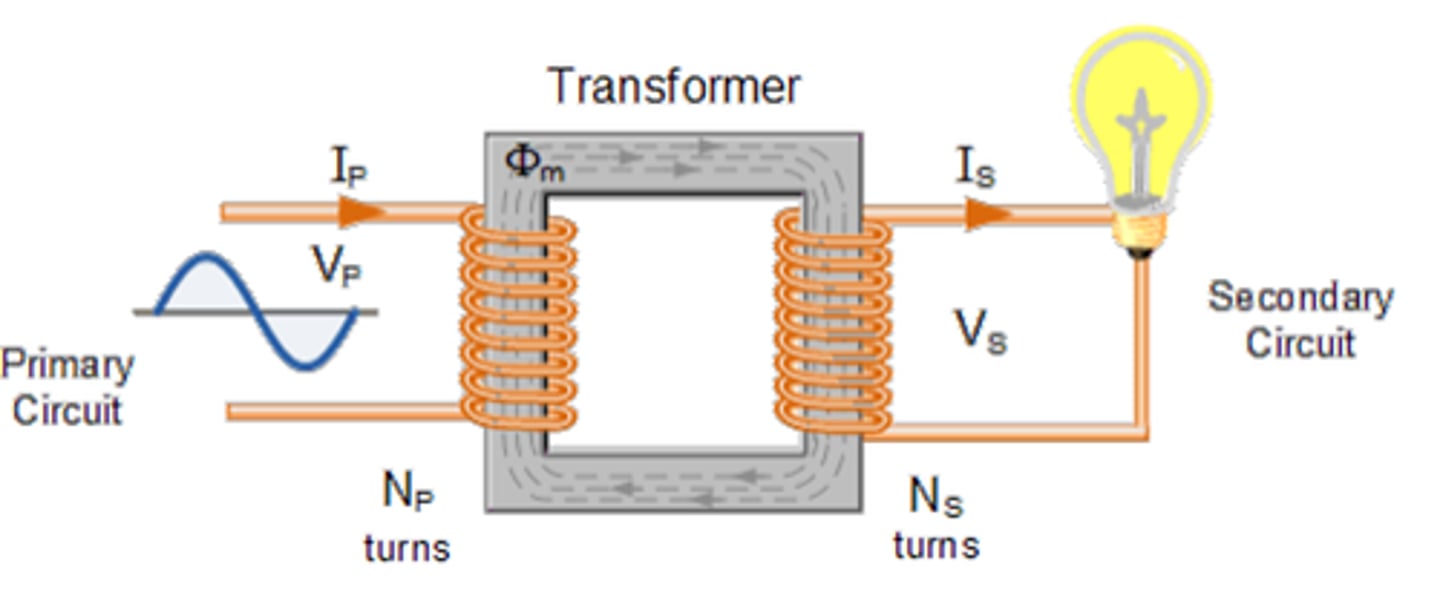
What is meant by a step-up transformer? (1)
This is a transformer that raises the voltage of alternating current sources using electromagnetic induction.
What is meant by a step-down transformer? (1)
This is a transformer that lowers the voltage of alternating current sources using electromagnetic induction.
How does a transformer work? (3)
- A transformer is an iron core with a primary input coil and a secondary output coil.
- The alternating current in the primary coil then induces a varying magnetic flux in the iron core which induces an emf in the secondary coil due to Faraday's law.
- The iron core ensures energy is transferred between the primary and secondary coil and the secondary coil then outputs energy.
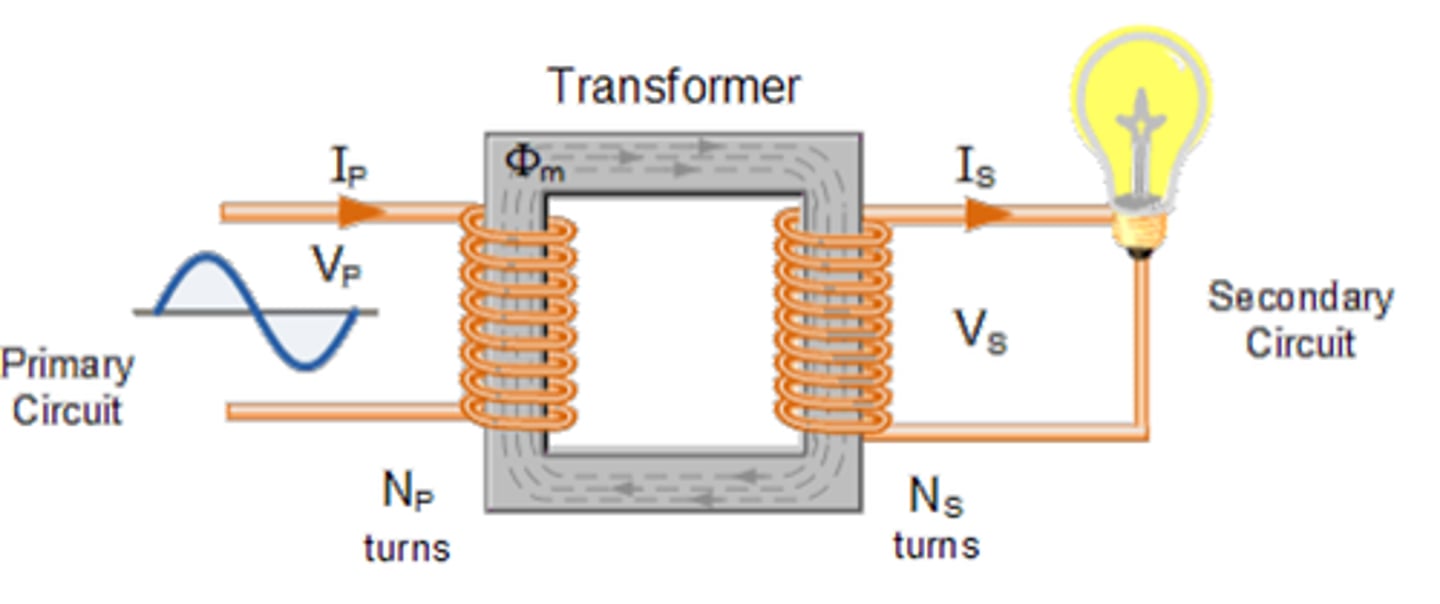
What is the equation for the changing magnetic flux in the primary coil in a transformer? (2)
- This is given by ∆Φ = -V_p ∆t /N_p
- Where ∆Φ is the changing magnetic flux (Wb), V_p is the potential difference in the primary coil (V) and N_p is the number of turns in the primary coil.
What is the equation for the emf induced in the secondary coil in a transformer? (2)
- This is given by V_s = -N_s ∆Φ/∆t
- Where ∆Φ is the changing magnetic flux (Wb), V_s is the potential difference in the secondary coil (V) and N_s is the number of turns in the secondary coil.
What is the relationship between the number of coils and potential difference in a transformer? (2)
- By substituting ∆Φ = -V_p ∆t/N_p into V_s = -N_s ∆Φ/∆t the following relationship can be found:
- N_s/N_p = V_s/V_p
What is the relationship between potential difference and current in a transformer? (3)
- Assuming transformers to be 100% efficient the power input is equal to the power input.
As P = IV we can find I_p V_p = I_s V_s where I_p is the current in the primary coil (A) and I_s is the current in the secondary coil (A).
This can be used to find the relationship: N_s/N_p = V_s/V_p = I_p/I_s
What is the condition for a transformer to be step-up? (1)
- If the number of turns in the secondary coil are more than the primary coil, the transformer is step-up.
- From N_s/N_p = V_s/V_p we can find V_s = N_s V_p/N_p which is larger than the potential difference in the primary coil so it is a step-up transformer.
What is the condition for a transformer to be step-down? (1)
- If the number of turns in the secondary coil are less than the primary coil, the transformer is step-down.
- From N_s/N_p = V_s/V_p we can find V_p = N_p V_p/N_s which is smaller than the potential difference in the primary coil so it is a step-down transformer.
What are the applications of transformers? (2)
- Step-up transformers are used to minimise power losses in the transmission cables of the National Grid, as P = V^2/R with a high voltage, the power transferred is very large.
- Step-down transformers are used to decease the voltage from the transmission cables so it is safer to distribute to consumers in homes and factories.
How can the output of a transformer be investigated? (1)
- Using the equation N_s/N_p = V_s/V_p} varying the number of coils will change the output of the transformer.
How can the efficiency of a transformer be investigated? (2)
- The current and potential difference at each coil of the transformer can be measured.
- The efficiency is the ratio of the power output to the power input given by:
- η = P_out/P_in = I_p V_p/I_s V_s
What is the equation for the efficiency of a transformer? (1)
- This is given by: η = P_out/P_in = I_p V_p/I_s V_s
How can transformers be made more efficient? (3)
- Using low resistance wires in the coils will reduce power loss to resistive heating.
- Use laminated iron which reduces power loss from magnetic heating.
- Use soft iron cores as they are more susceptible to the changing magnetic fields and improve the overall efficiency.
How can using low resistance wires in coils make transformers more efficient? (1)
This will reduce power loss as P = V^2/R so a lower resistance will mean more power is transferred and the efficiency is increased.
How can using laminated iron make transformers more efficient? (1)
Laminated iron reduces power loss from magnetic heating.
How can using soft iron cores make transformers more efficient? (1)
Soft iron cores are more susceptible to the changing magnetic fields and improve the overall efficiency.